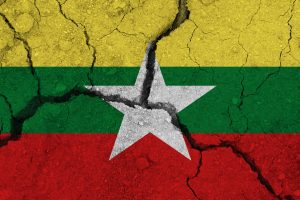A powerful ethnic armed group in Myanmar’s west says that it is on the verge of capturing Maungdaw, a mainly Rohingya town close to the country’s border with Bangladesh, and has called on its residents to evacuate as a matter of urgency.
In a statement yesterday, the United League of Arakan (ULA) announced that its armed wing, the Arakan Army (AA), had “seized nearly all of the [junta’s] military camps in Maungdaw Township” and that “further assaults on the remaining camps are imminent.”
It added that “due to concerns for the safety of the residents of Maungdaw,” it was “urgently” advising the residents to evacuate, starting at 9 p.m. yesterday.
The AA has made significant gains in Rakhine State since the collapse of a ceasefire with the military junta in November, and now exercises primary control over nine of the state’s 17 townships. The announcement came after numerous reports of fierce fighting along the Bangladeshi border, with the AA claiming on Saturday to have captured 10 junta camps “in less than two weeks,” and killed around 200 Myanmar military personnel.
The AA’s statement implies that the group is closing in on the capture of Maungdaw, which would complete its control of the northern part of Rakhine State and give the AA control of the bulk of the country’s border with Bangladesh, bringing its goal of an independent ethnic Rakhine state another step closer to fruition.
However, the statement also conceals an ominous warning to the Rohingya Muslims living in the township. After the AA captured the neighboring town of Buthidaung last month, arson attacks reduced large parts of the town to ash, forcing tens of thousands to flee. Rohingya eyewitnesses claimed that the AA was responsible for the attacks; the group vociferously denied the claims, blaming junta air and artillery strikes.
However, there is now substantial evidence that these arson attacks were indeed carried out by the AA. As Nathan Ruser concluded in an exhaustive report for the Australian Strategic Policy Institute last week, Buthidaung was burnt by the AA in retaliation for earlier arson attacks by the military junta and Rohingya militants on predominantly Buddhist and Hindu neighborhoods. Beginning on April 11, these attacks “destroyed roughly 2,400 structures across 150 acres of Buthidaung town.”
Then, from April 24, the AA “began an arson campaign against Rohingya villages, retaliating against the whole Rohingya community for arson attacks in Buthidaung town.” This was then extended to the town itself after it was captured by the AA on May 17. In total, Ruser estimated, these attacks “destroyed 8,500 structures across around 50 villages.”
All of this raises dire concerns for the fate of the Rohingya that remain in Maungdaw ahead of the AA’s impending final push toward the town. Most are survivors of the genocidal “clearance operation” launched by the Myanmar military in August 2017, which ended up driving more than 740,000 Rohingya civilians across the border into Bangladesh and wiped dozens of Rohingya villages off the map.
While there is some chance that the increased international scrutiny of the AA may prevent it from carrying out similar attacks in Maungdaw, the group arguably does not deserve the benefit of the doubt – and the evacuation order seems to suggest that it will take no responsibility for any civilians remaining in Maungdaw if and when it captures the town.
Aside from this, there is the obvious question of where the civilians are supposed to go. Maungdaw is a relatively remote township, poorly connected to other parts of Rakhine State. Two major roads lead out of the town: one running east to Buthidaung and the other south along the coast in the direction of the state capital Sittwe, which remains under junta control.
The first route was closed by the AA after the capture of Buthidaung, which reportedly prevented displaced Rohingya from making their way to Maungdaw. Based on this precedent, it is doubtful that the group would permit civilians to flee to Buthidaung, where thousands of Rohingya civilians remain displaced. It is equally unlikely that the AA would let Rohingya flee south toward Sittwe, given its concern that the junta is seeking to conscript Rohingya and use them to fight the AA. In any event, recent history shows that the junta authorities are no friends of the Rohingya.
The only remaining exit route is across the Naf River into Bangladesh, which nearly three-quarters of a million Rohingya were forced to traverse following the military’s “clearance operation” in 2017. However, it is equally hard to see the Bangladesh government allowing, let alone welcoming, another influx of civilians from Rakhine State, given its growing discontent about the 1 million refugees that are already there.
All this adds up to more grim tidings for the Rohingya, and another cautionary note about the course of the country’s civil war, which looks now looks as likely to end in ethnic balkanization and fragmentation as to produce an inclusive federal democracy. While many of Myanmar’s ethnic armed groups have been united by their opposition to the military, the recent actions of the AA highlight the divergences in their political visions, and the eternal reality that the oppressed are not immune from oppressing in their own turn when they have the power to do so. In fact, the situation in Rakhine State points to the limits of a politics rooted in the reification of ethnic and religious identities, which so often contain the seeds of exclusion and oppression. Perhaps the most sobering lesson to draw from the recent events in western Myanmar is the degree to which the ethno-religious Rakhine nationalism of the ULA/AA resembles the Bamar chauvinism against which it seeks to define itself.

































